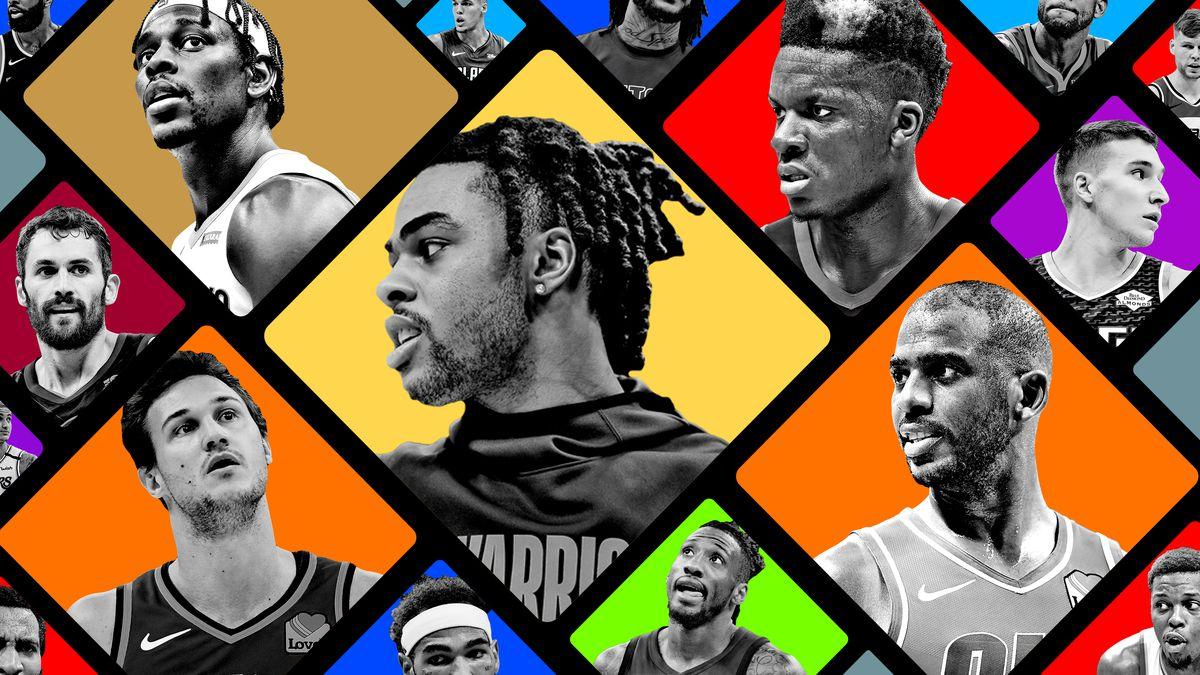
The Lakers are still a mystery. Basketball has been the furthest thing from their minds during the past week, but Thursday’s looming trade deadline will force them to make some tough decisions about a roster they still don’t know much about. The Lakers have been playing all season with one hand tied behind their back, which is weird to say about a team with the second-best record in the NBA.
A lot has gone right on the court in Los Angeles this season. LeBron James and Anthony Davis have played like MVP contenders, while the team has clicked on both ends of the floor under new head coach Frank Vogel. The Lakers boast a top-five offense and defense, a sure sign of a championship contender. They also have a healthy 3.5-game lead over the Clippers in the race for the no. 1 seed out West, which would push their biggest obstacle to making the Finals on the other side of the conference’s bracket.
But the Lakers should be an even more dangerous force in the playoffs, regardless of what they do this week. The whole point of pairing LeBron and Davis together this summer was to use them in the pick-and-roll. They could end up being the best 1-2 punch on the NBA’s bread-and-butter play in league history. They are just so much bigger and more talented than any group that has ever come before them—Steph Curry and Draymond Green, Steve Nash and Amar’e Stoudemire, John Stockton and Karl Malone. There’s no defense for a ball handler as big as LeBron barreling down the lane with the option of giving the ball to an even bigger teammate who can score over the top of anyone. The only way to stop them is to crowd LeBron with extra defenders, creating openings for him to pick apart the defense and find open shooters along the 3-point line.
That scenario is still mostly theoretical, though. The Lakers have run very little pick-and-roll this season. They are no. 25 in the NBA in the percentage of offense that comes from the ball handler in the play and no. 29 in the percentage that comes from the roll man. Davis has used almost twice as many of his offensive possessions in the post (23.5) as the pick-and-roll (12.3).
The problem is the lineups the Lakers have been using. Davis has spent roughly two-thirds of his time on the floor next to a more offensively limited center in either JaVale McGee or Dwight Howard. Neither McGee nor Howard can play on the perimeter, which keeps both them and their defender in the paint. Davis actually often ends up spacing the floor for one of them to roll to the basket. It’s not that the two have played poorly. They have done everything the Lakers have asked of them. But they are a pair of governors on a high-performance engine. They have to go in order for the Lakers to reach full speed.
Traditional big men have become a necessary evil for elite teams. The season is too arduous to expose Davis to unnecessary banging in the paint, especially given his long history of injuries. He has always preferred playing power forward to avoid some of the punishment that comes with wrestling with centers like Steven Adams and Rudy Gobert for six months. The Lakers have been starting Davis at the 4 in the regular season for the same reason the Warriors did with Draymond Green in recent years. They are saving their best lineups for when it really matters—in the playoffs. Golden State even had McGee in the same role as a starting center who eventually gave way to smaller lineups.
Davis doesn’t necessarily have to play center. He will be an unrestricted free agent in the offseason with a ton of leverage on a franchise that gave up the farm to acquire him. But he has been willing to play the position before in the playoffs. The only time he has ever advanced past the first round came in 2018, when New Orleans swept Portland by downsizing lineups with Nikola Mirotic at the 4 and Davis at the 5.
The benefits of the move are simply too big to overlook. The game is a lot different in May and June than November and December. It’s the reverse of how things were a generation ago. Instead of getting slower in the latter stages of the playoffs, the game gets faster and more wide open.
There are no playoff teams in the West with the size to stop the Lakers from playing Davis at the 5. The only player in the entire league who they might worry about in that matchup is Joel Embiid, and the odds of the 76ers making the Finals at this point seem poor. L.A. is far more likely to play the Bucks, who don’t have anyone for McGee or Howard to regularly guard.
There’s also a domino effect that comes with moving Davis to the 5. Playing small ball transforms their third-best scorer—Kyle Kuzma—from a luxury item into an invaluable piece. Kuzma has suffered the most in the Lakers’ new arrangement. There is no spot in the lineup for the third-year combo forward with LeBron at the 3, Davis at the 4, and either McGee or Howard at the 5. He has gone from starter to sixth man and is playing eight fewer minutes per game than last season.
Kuzma has been great in the rare times where he has, in fact, played with LeBron and Davis. The Lakers have an eye-popping net rating of plus-21 in 183 minutes with all three on the floor this season.
His reputation is a little skewed. Kuzma is a bigger celebrity than many more accomplished players because of where he plays, but he’s also better than he’s given credit for now that the backlash has swung things the other way. There aren’t many players with his size (6-foot-8 and 220 pounds) who possess his combination of athleticism, shooting, and ball skills.
Kuzma is a natural scorer. He doesn’t need to hold the ball for long. He moves well without it and he can put up points in a hurry. He’s third on the Lakers in points per touch (0.362) behind only Davis and Troy Daniels, a 3-point shooting specialist. He showed all the different ways he can score—pick-and-roll, posting up, spotting up, cutting to the rim, offensive rebounding, and getting to the line—when he dropped 36 points a win against the Thunder in January:
Neither LeBron nor Davis played in that game. But the way that Kuzma scores can be effective with both on the floor. It’s hard to play third fiddle in those lineups. LeBron, even at 35, is one of the most ball-dominant players in the NBA. He’s second behind only Nikola Jokic in touches per game (93.8), and he holds the ball for twice as long per game (7.5 minutes). And Davis has far more plays run for him than most big men. That’s where having a player who can score without having his number called becomes valuable.
The Lakers have a five-man lineup that fits almost perfectly together in LeBron, Davis, Kuzma, and two three-and-D wings in Danny Green and Kentavious Caldwell-Pope. They can run everything through LeBron and Davis, use Kuzma to fill in the blanks, and space the floor with Green and KCP. There aren’t many holes on either end of the floor. LeBron and Kuzma are their two worst defenders, and they are still huge forwards who can switch on screens and stay in front of smaller guards. That lineup has been dominant in the rare times when Vogel has gone to it, with a net rating of plus-25.6 in 42 minutes.
The question the Lakers have to decide this week is whether Kuzma can be more valuable in small-ball lineups than any player they could acquire for him. The lack of opportunities in the regular season has made Kuzma a near-constant presence in trade rumors. He’s the one player in their supporting cast who could get a solid return in trades because of his age (24) and salary ($1.97 million).
Los Angeles could use another perimeter playmaker for its title run. They don’t have any effective point guards behind LeBron. They have been using Rajon Rondo, who has been largely ineffective, in that role. It’s the primary reason why they have been much less effective (minus-7.2 in 409 minutes) this season when Davis plays without LeBron.
There have been a couple of interesting reports regarding the Lakers. One had Kuzma going to Sacramento for Bogdan Bogdanovic, who would give them a shooter who can space the floor for LeBron while being able to run the offense without him. But the Kings swiftly rejected that offer.
Another option would be to send Kuzma and the salary of DeMarcus Cousins, who is out for the season after tearing his ACL, to the Pistons for Derrick Rose, who is having his best season in almost a decade, averaging 18.5 points on 49.8 percent shooting and 5.8 assists per game.
But there could be other ways for them to fill that hole. The Lakers have long been rumored as a possible destination for Andre Iguodala, the former Warriors swingman who has been sitting out all season after being traded to the Grizzlies. While Memphis has said they will not buy out the veteran, there’s still no sign of them being close to a deal. The other player floating around is Darren Collison, a 3-and-D point guard who unexpectedly retired in the offseason but has said that he wants to return. Both the Lakers and the Clippers have been pursuing him, but Collison said he will not make a decision until after the trade deadline.
The deadline for any free agents or buyout candidates to change teams and be eligible for the postseason is March 1. The Lakers have a lot of options to consider in the next few weeks. They don’t necessarily have to make a trade to get better—that will happen anyway. There is no contender that could make a bigger transformation from the regular season to the playoffs.


